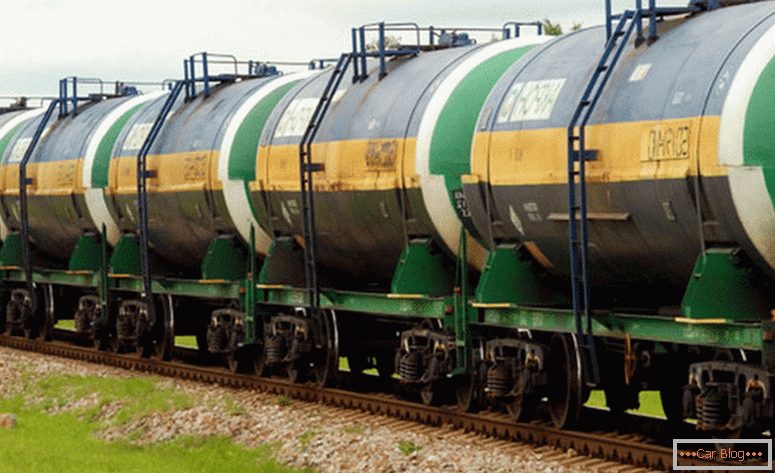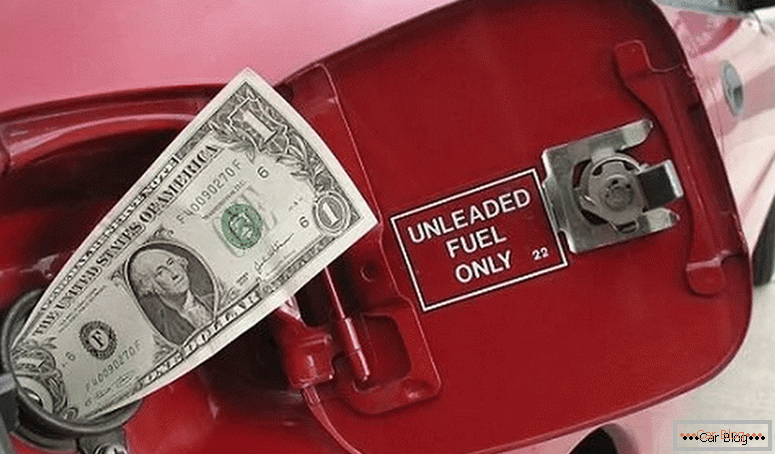The prices of world oil markets are going down lately. Sometimes faster, and when slowing down. Another thing is the price tags at gas stations. Their movement is in the opposite direction. There is a natural desire to find out the dilemma of why oil is getting cheaper, gasoline is becoming more expensive.
Speaking at the end of 2014, the Russian president noted that the price of crude oil in the world declined by more than a third over the year, while at retail the fuel went up by 10%. This happened against the background of a small decline in wholesale oil. At the same time, economists explain these paradoxes by the fact that, in fact, the final cost of gasoline at gas stations is not only the cost of raw materials, but includes several diverse components.
Content
- 1 Oil in the price of gasoline
- 2 How much is excise duty to the buyer
- 3 Ways of transportation
- 4 Devaluation
- 5 Pricing Prospects
- 6 Conclusion
Oil in the price of gasoline
Watching the falling quotations of oil from the evening news, many Russians are trying to understand the logic of why gasoline is becoming more expensive. But it turns out that not all matters in oil. Its share in the final retail product takes about 30% of the total financial burden. This part can not fully affect the entire cost of fuel.
Having carried out simple arithmetic calculations, it can be seen that a reduction in the price of raw materials by 10% should result in a final decrease of about 3%.
Given the decline in raw materials at the level of 40-50%, car owners should have received a discount of 15%. But such happiness did not happen.

The share of taxes in the cost of gasoline
There was only a slight spring fall, and summer brought everything back. And the autumn of 35 rubles per liter does not set up optimism. After all, the expected fall at least insignificant, does not occur at all. Maybe Russia is a unique country in economic terms.
See also: How to make a freeze at homeHow much is excise duty to the buyer
Almost equal shares in gasoline with the price of oil laid excise. This is actually an additional tax that the state takes from each liter of fuel sold. It accounts for 28% of the volume of the final product sold. At the beginning of 2013, its rate was 10.1 thousand rubles per ton. Since the beginning of 2014, its size is already 11.1 thousand. Therefore, the officials, calling for lower prices, raise them themselves.
Summer take-off is also attributed to increased excise.

Prices for zapraka
After all, at the beginning of 2015, the rate rose sharply to 13.3 thousand per ton. Such a jump could not go unnoticed in the oil market. Although it was not the main factor in the fact that gasoline prices went up.
Modes of transportation
In the remaining part of the price of oil (42%), most of the responsibility lies with the transportation of both the finished product and crude oil to refineries.
In addition to payments on excise and other types of payments required to engage in the supply and marketing of products.

Transportation of fuel by railway
Delivery is carried out in two ways:
- main pipelines;
- rail transportation.
Both species have recently risen in price for manufacturers. So, for the services provided, Russian Railways has requested almost a 14% increase since December 2014, and in early 2015, the railway workers still raised the cost of services by 10%. The owners of the pipe pumping companies also wished to receive additional revenues for pumping raw materials. Their appetite stopped at an 8% increase in transport charges.
Devaluation
The rise in prices in ruble terms did not affect prices in terms of dollars.

Due to the fall of the national unit, the high yield in the oil refining industry did not happen. All ate devaluation.
See also: Driver's actions in case of accident: instructionProspects for pricing
In 2016, the transition to the new Euro 5 fuel standard is expected. A more environmentally friendly product can play another game with the Russians in price increases. Although the Minister of Economy assures the opposite. But today, the decision on the complete withdrawal from the turnover of the Euro 4 standard has not yet been made. Industry experts are trying to extend its use next year.
Conclusion
Summarizing the results of the study, we can conclude that, with such a decrease in the price of crude oil in 2015, gasoline should be cheaper by about 5%. However, this did not happen.
All attempts to reduce the cost were offset by an increase in excise duty, transportation costs, and other minor factors. Therefore, one can hardly expect any further reduction in the price of gasoline from further changes in the cost of oil.



